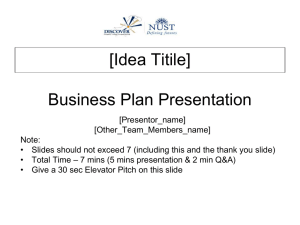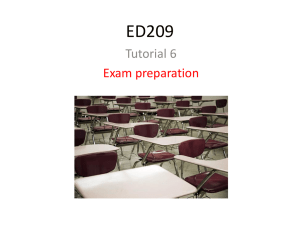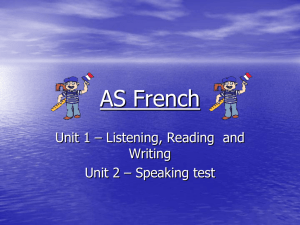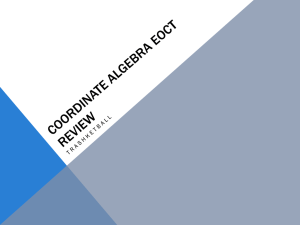Collision Detection and Response
advertisement
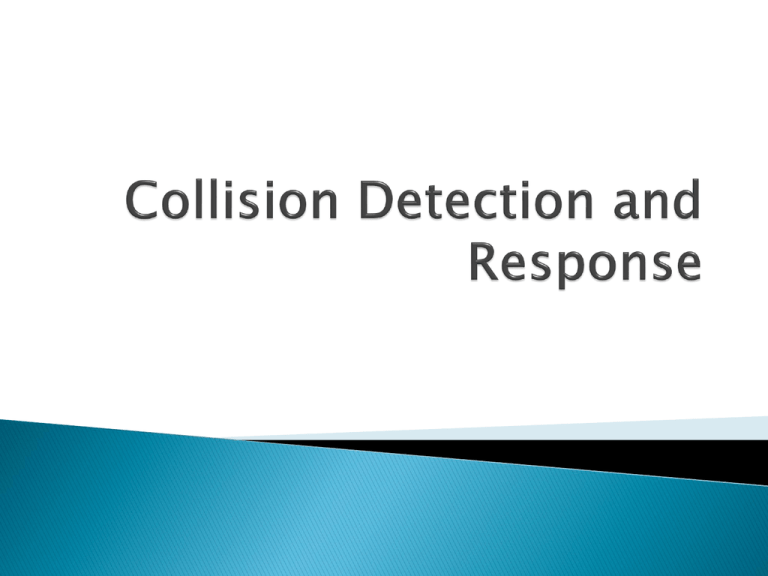
Here is where I want my object to be Here is where my object is Here is where my object is going to be A box that is Initial Airplane Orientation ◦ Defined by the min and max coordinates of an object ◦ Always aligned with the coordinate axes How can we tell if a point p is inside the box? Airplane Orientation 2 Do a bunch of ifs ◦ if( px<= maxx && py<= maxy && pz<= maxz && px>= minx && py>= miny && pz>= minz ) then collide = true; else collide = false minx maxx maxy P miny if mins/maxes overlap then collide = true else collide = false; Bmaxy Bminx Bmaxx Amaxx Aminx Bminy Initialization: Iterate through vertices and find mins and maxes After Transformations: Iterate through AABB vertices and find mins and maxes Initialization ◦ iterate through all vertices of your model to find the mins and maxes for x, y, and z During runtime ◦ Test if any of the AABB mins/maxes of one object overlap with another object’s AABB mins/maxes MAKE SURE THAT THE AABB VALUES ARE IN THE SAME COORDINATE FRAME (e.g., world coordinates)! If they aren’t, then manually transform them so they are. This is equivalent to multiplying the 8 points by a matrix for each object Then make sure to recalculate your mins/maxes from the 8 transformed points! Note: it is possible to do this with only 2 points from the box: (minx,miny,minz), (maxx,maxy,maxz), but not required Keep a position p and a unit vector v. Each frame add the vector to the position p+v*speed, This is essentially how the camera works in my latest code sample on my webpage How about gravity? ◦ Add a gravity vector (e.g., g = [0,-1,0] ◦ v+=v+g*gravity ◦ p +=v*speed ◦ glTranslatefv(p) ◦ where gravity and speed are float Equation: Ax+By+Cz+D = 0 ◦ [A,B,C] is the normal of the plane ◦ D is how far from the origin it is p = (xp,yp,zp) What is the shortest distance from p to the plane? Axp+Byp+Czp+ D = signed distance (assuming [A,B,C] is length 1) For AABBs, normals are always going to be parallel to a principle axis e.g., x-axis: [A,B,C] = [1,0,0] + [A,B,C] P D - Manually (i.e., make your own matrix multiplication functions) transform all things collidable into the same coordinate frame (e.g. world coordinates) E.g., if you have : gluLookat(…) glPushMatrix() glPopMatrix() ◦ glTranslatefv(p); ◦ Draw sphere projectile glPushMatrix(); ◦ glRotate(a,x,y,z) ◦ glTranslate(tx,ty,tz) ◦ Draw a BB glPopMatrix() The p here is already a position in world coordinates! YAY! RT matrix Get the vertices of this BB and multiply them by the RT matrix: e.g., RTvi for each of the 8 vertices, vi. This will put the BB into world coordinates Manually transform the projectile into the BB’s object coordinate frame (less work for cpu) E.g., if you have : gluLookat(…) glPushMatrix() glPopMatrix() ◦ glTranslatefv(p); ◦ Draw sphere projectile glPushMatrix(); ◦ glRotate(a,x,y,z) ◦ glTranslate(tx,ty,tz) ◦ Draw a BB glPopMatrix() 1) Multiply p by (RT)-1 or (-T)(-R)p 2) And do the same its direction vector v 2) do collision detection and response calculations with the untransformed BB 3) Put p back into world coordinates with RTp and its direction vector v RT matrix Watchout for non-uniform scaling – for this you would need do do multiplications of the form M-1Tv collide = true; // then what? ◦ Calculate ray intersection with the plane ◦ Calculate reflection vector (sound familiar?) ◦ Calculate new position Rays are made of an origin (a point) and a direction (a vector) Refldirection N Current Position Rayorigin Next Position Make sure N and Raydirection are normalized! Adjacent = A*RayoriginX + B*RayoriginY + C*RayoriginZ +D adjacent / cos(θ) = hypotenuse ◦ That is, dot (Raydirection , N) = cos(θ) Rayorigin+Raydirection*hypotenuse = i Refldirection N θ i Rayorigin θ Really we should use physics here but… Think back to lighting ◦ Refldirection =-2dot(N, Raydirection) *N + Raydirection Refldirection N θ i Rayorigin θ 1) test collisions and response on untransformed objects before trying it with applied transforms ◦ Actually, the only requirement is projectile transformations. 2) use spheres for the projectiles ( you can basically treat these as points) and then you do not need to implement separating axes with OBB 3) draw your bounding boxes so you can see them (this is actually required is the project) 4) graduates : Don’t worry, I don’t expect terrain collisions A box that ◦ Stays oriented to the model regardless of transformations ◦ These are often defined by artists in the 3D modeling program ◦ There are algorithms to compute the minimum OBB, but this is out of scope for this class ◦ How to create the initial box? 1) Either: Iterate through vertices (same as AABB Make a nice box with a modeling program 2) Convert to plane equations Airplane Orientation 1 Airplane Orientation 2 Take 3 vertices from one side of your box Compute the normal ◦ [v3-v1] X [v2-v1] = [a,b,c] ◦ Normalize the normal ◦ [A,B,C] =[a,b,c] / ||[a,b,c]|| v2 Solve the following: ◦ Ax +By+ Cz + D = 0 Plug in a point we know is on the plane ◦ Av1x + Bv1y + Cv1z = - D v3 v1 Equation: Ax+By+Cz+D = 0 ◦ [A,B,C] is the normal of the plane ◦ D is how far from the origin it is p = (xp,yp,zp) What is the shortest distance from p to the plane? Axp+Byp+Czp+ D = signed distance (assuming [A,B,C] is length 1) [A,B,C] P D + - If( a point evaluates to be <=0 distance from all 6 planes that make up the box Then collide = true Else collide = false Test whether any of the 8 points that make up one box collide with the other ◦ Do this for both boxes. ◦ This won’t always work in 3D… In ANY of the following cases, if all of the collision tests evaluate to positive, then assume no intersection ◦ 1) Test collisions between all the vertices of BBA and all the planes of the BBB ◦ 2) Test the collisions between all the vertices of BBB and all the planes of the BBA ◦ 3) Then test collisions between all the vertices of BBA and BBB and all cross products of each pair of edge normals of BBA and BBB This actually works for any convex polyhedron. There are optimizations for OBBs… Again, you will have to make sure that all planes, points, etc are in the same coordinate frame when computing collisions. Think about normals ◦ Vertex: Mv as usual ◦ Normal: M-1Tn, n= [A,B,C,0]T // this is a vector! Transform the plane equation ◦ p = [A,B,C,D] ◦ Matrix M = arbitrary transforms M-1Tp ◦ OR, if you don’t have any non-uniform scaling Mp What would happen if you had non uniform scaling?


